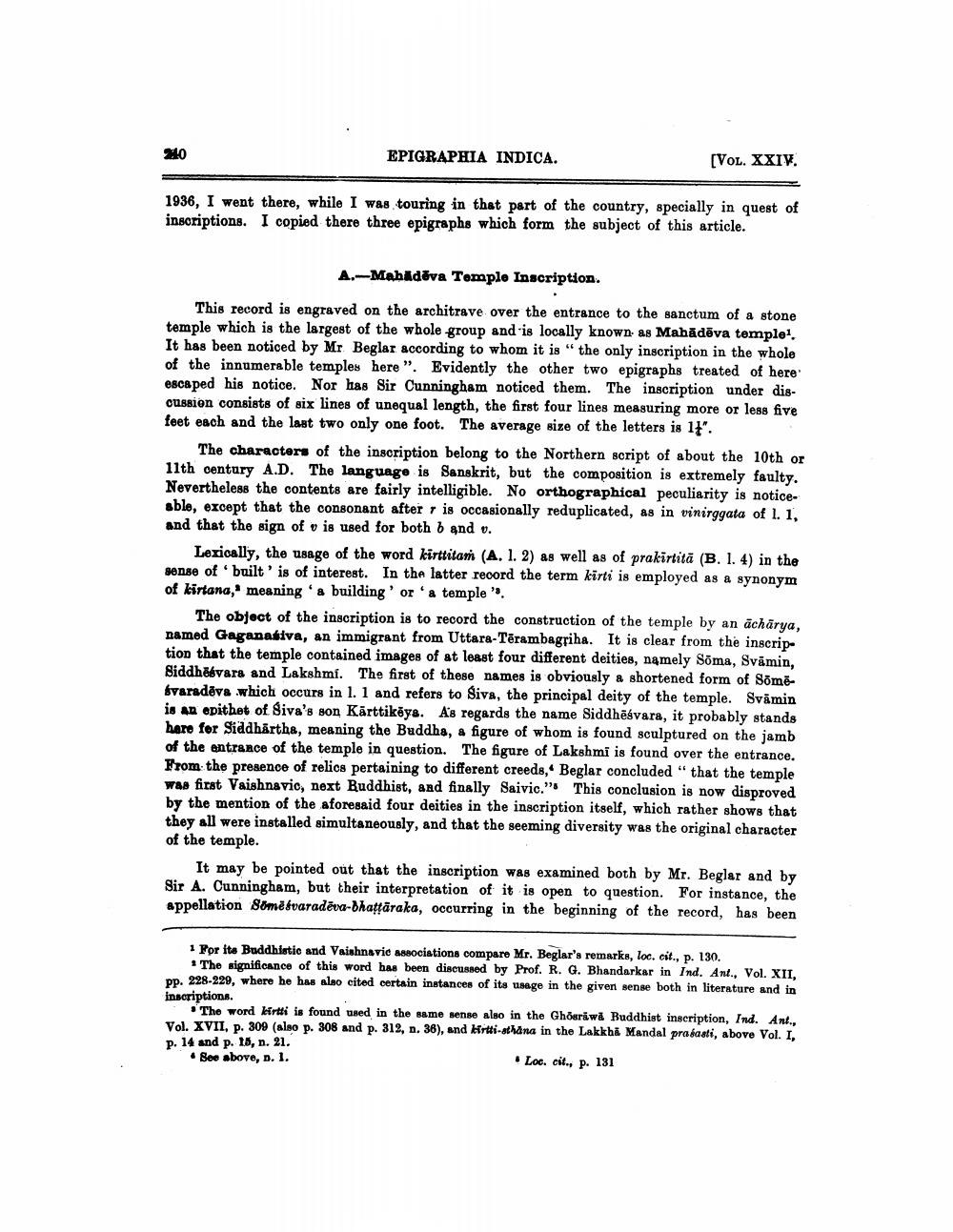________________
20
EPIGRAPHIA INDICA.
[Vol. XXIV.
1936, I went there, while I was touring in that part of the country, specially in quest of inscriptions. I copied there three epigraphs which form the subject of this article.
A.-Mahldēva Temple Inscription.
This record is engraved on the architrave over the entrance to the sanctum of a stone temple which is the largest of the whole group and is locally known as Mahādēva templel. It has been noticed by Mr Beglar according to whom it is "the only inscription in the whole of the innumerable temples here". Evidently the other two epigraphs treated of here escaped his notice. Nor has Sir Cunningham noticed them. The inscription under discussion consists of six lines of unequal length, the first four lines measuring more or less five feet each and the last two only one foot. The average size of the letters is 14".
The characters of the inscription belong to the Northern script of about the 10th or 11th century A.D. The language is Sanskrit, but the composition is extremely faulty. Nevertheless the contents are fairly intelligible. No orthographical peculiarity is noticesble, except that the consonant after ris occasionally reduplicated, as in vinirggata of 1.1, and that the sign of v is used for both b end o.
Lexically, the usage of the word kirttitam (A. 1. 2) as well as of prakirtitā (B. 1. 4) in the sense of built' is of interest. In the latter record the term kirti is employed as a synonym of kirtana,' meaning & building' or 'a temple'.
The object of the inscription is to record the construction of the temple by an acharya, named Gaganabiva, an immigrant from Uttara-Tērambagriha. It is clear from the inscription that the temple contained images of at least four different deities, namely Soma, Svåmin, Siddhēsvara and Lakshmi. The first of these names is obviously a shortened form of Somesvaradēvs .which occurs in l. 1 and refers to Siva, the principal deity of the temple. Svämin is an epithet of Siva's son Kärttikēys. As regards the name Siddhēśvara, it probably stands here for Siddhartha, meaning the Buddha, a figure of whom is found sculptured on the jamb of the entrance of the temple in question. The figure of Lakshmi is found over the entrance. From the presence of relics pertaining to different creeds, Beglar concluded that the temple was first Vaishnavio, next Buddhist, and finally Saivic.” This conclusion is now disproved by the mention of the aforesaid four deities in the inscription itself, which rather shows that they all were installed simultaneously, and that the seeming diversity was the original character of the temple.
It may be pointed out that the inscription was examined both by Mr. Beglar and by Sir A. Cunningham, but their interpretation of it is open to question. For instance, the appellation Somēdvaradēva-Bhattāraka, occurring in the beginning of the record, has been
1 Por ite Buddhistic and Vaishnavie associations compare Mr. Beglar's remarka, loc. cit., p. 130.
The significance of this word has been discussed by Prof. R. G. Bhandarkar in Ind. Ant., Vol. XII, pp. 228-229, where he has slao cited certain instances of its usage in the given sense both in literature and in inscriptions.
• The word kirti is found used in the same sense also in the Ghosrawa Buddhist inscription, Ind. Ant., Vol. XVII, p. 309 (also p. 308 and p. 312, n. 38), and birtti-athana in the Lakkha Mandal prasasti, above Vol. I, p. 14 and p. 18, n. 21. • See above, D. 1.
• Loc. cit., p. 131




